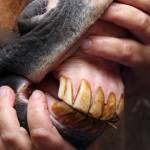Equine Dental Disease: Caries and Cavities

Throughout the long history of horsemanship, tooth decay ranked low among health problems that debilitated young or even middle-aged horses. Advances in dentistry of late have, however, uncovered some interesting facts that are shaking up how horsemen think about oral health among horses. In one study of nearly 930 horses, for example, about 8% were affected with dental caries, which is the microbial degradation of teeth characterized by loss of calcified tissue.§
“In many cases, feed becomes packed into the periodontium, a group of specialized tissues that anchor the teeth into the jawbones. This accumulation of chewed feed can eventually lead to caries,” said Rebecca Ham, a nutrition advisor for Kentucky Equine Research. A recent review of equine dentistry indicated a direct relationship between dental caries, feed impaction, and periodontal disease.*
The presence of half-chewed feed between teeth causes damage to the periodontal structures primarily through a change in the bacterial population that inhabits the vicinity of the impaction. Pathogenic bacteria flourish on nearby molars and create a biofilm, a complex microbial community that adheres steadfastly to a surface through a complicated network of macromolecules. Because the drainage openings of the salivary ducts are located nearer the muzzle than the molars, researchers theorize affected teeth are not bathed with saliva, which allows acids produced by the bacteria to be left unbuffered.○ If the acidity of the biofilm drops low enough, demineralization begins and a caries forms.
Feed impaction between teeth is thought to be caused in part by altered chewing patterns that occur when teeth shift out of alignment, which can occur with age or with uncorrected dental problems.
Owners can often sidestep the long-term effects of caries through diligent dental care. Have a reputable, experienced dentist perform a thorough examination at least once a year. Underlying conditions predisposing a horse to feed impaction can be identified and potentially treated, such as abnormal spaces between teeth.
If your horse is diagnosed with dental caries, what is the best nutritional plan?
Regarding forage, “there is some evidence that horses with access to quality pasture year-round are less likely to have caries compared to horses without access to grazing,” explained Ham. With soft feedstuffs, such as green pasture grass, horses use a wider range of motion with their lower jaw as they chew which, among other benefits, generates more saliva and thus more buffering potential.•
Despite the advantage of soft forage, hay will likely remain an integral dietary component for many horses, even for those susceptible to dental caries. Some horses will have free-choice access to hay, while others, such as those prone to weight gain, will be fed hay with devices that slow intake. In one epidemiological study of risk factors for dental caries performed in Western Australia, certain hay types, such as oaten hay, with its higher sugar content, were connected to the development of caries, while others, like meadow hay, were protective.+ Horses predisposed to periodontal disease and thus caries may benefit from soaked hay as a way to soften forage.
“In addition, carefully consider other forages being offered to your horse. Particles of certain forage products can get trapped easily between teeth of susceptible horses, like chaff,” advised Ham.
If your horse is fed an all-forage diet, be sure to balance nutrient intake with a high-quality vitamin and mineral supplement.
Many horses require concentrates to sustain growth, pregnancy, lactation, and performance. For horses with known dental problems, pelleted feeds may be preferable as individual pellets will crumble easily as they are dampened with saliva and pulverized by the molars. Because the ground pieces of feed are minute, they can be dislodged easily by other fragments of feed as the horse continues to eat or by the sloshing of water as it drinks. Pelleted feeds may also be dampened before being offered to the horse so saliva isn’t absorbed by the pellet, thus giving saliva the chance to work as a buffer.
When Is a Cavity a Caries?
While it can be tempting to classify a cavity and a caries as synonyms, that simplification proves too untidy for some researchers. For these experts, a distinction is necessary: a caries is a specific pathology related to bacterial disease and demineralization, while a cavity is any defect in the surface of the tooth from any cause, such as erosion, fracture, resorption, or caries. According to one veterinarian, “traditionally, caries has been the catch-all term used in the equine veterinary literature for the deterioration of dental tissues. Because multiple etiologies for dental decay in horses have been reported or suggested, use of the term cavity to represent tooth deterioration of undetermined pathology is more appropriate in the veterinary literature.”++
*Pearce, C.J. 2020. Recent developments in equine dentistry. New Zealand Veterinary Journal 68(3):178-186.
§Nuttall, H.E., and P.J. Ravenhill. 2019. Prevalence and analysis of equine periodontal disease, diastemata, and peripheral caries in first-opinion horse population in the U.K. The Veterinary Journal 246:98-102.
○Gere, I., and P.M. Dixon. 2010. Postmortem survey of peripheral dental caries in 510 Swedish horses. Equine Veterinary Journal 42:310-315.
•Klugh, D.O. 2006. A review of equine periodontal disease. In: Proc. American Association of Equine Practitioners Convention, p. 551-558.
+Jackson, K., E. Kelty, and M. Tennant. 2018. Equine peripheral dental caries: An epidemiological survey assessing prevalence and possible risk factors in Western Australian horses. Equine Veterinary Journal 50:79-84.
++Galloway, S.S. 2010. How to evaluate dental cavities in horses. In: Proc. American Association of Equine Practitioners Convention, p. 450-457.








